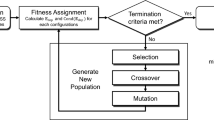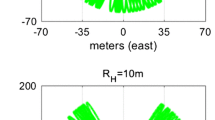Abstract
A scaling factor, S, is derived to account for the difference in path-weighted measurement heights of a combined system consisting of a large-aperture scintillometer (LAS) and a millimetre-wave scintillometer (MWS), operating at wavelengths of 0.88 μm and about 3 mm respectively, and designed to determine the area-averaged latent heat flux. This work extends an earlier derivation of Z ef , the effective height for the LAS yielding the area-averaged sensible heat flux. The LAS and MWS have different path-weighting functions, therefore, in general, it is expected that the path-weighted beam heights are different, for paths other than with the beam parallel to the land surface. Their difference will depend on the detail of the experimental set-up. The objective is to introduce a scaling factor that transforms the MWS refractive-index structure parameter measurement to the same path-weighted height of the LAS measurement. By applying S as a prelude to the calculation of the temperature and humidity structure parameters, and the sensible and latent heat fluxes, these quantities are made representative of the same measurement height, thus simplifying the application of two-wavelength scintillometry. The equations presented here enable the analysis of LAS-MWS paths such that they can be selected to optimize S towards its ideal value of unity. For this purpose we provide a new analytical approximation of the LAS path-weighting function. The importance of accounting for S is demonstrated by example applications over varying topography as well as for slanted beams.
Similar content being viewed by others
References
Andreas E (1989) Two-wavelength method of measuring path-averaged turbulent surface heat fluxes. J Atmos Ocean Technol 6: 280–292
Beyrich F, de Bruin HAR, Meijninger WML, Schipper JW, Lohse H (2002) Results from one-year continuous operation of a large aperture scintillometer over a heterogeneous land surface. Boundary-Layer Meteorol 105: 85–97
Beyrich F, Kouznetsov RD, Leps JP, Ludi A, Meijninger WML, Weisensee U (2005) Structure parameters for temperature and humidity from simultaneous eddy-covariance and scintillometer measurements. Meteorol Z 14: 641–649
Beyrich F et al (2006) Area-averaged surface fluxes over the litfass region based on eddy-covariance measurements. Boundary-Layer Meteorol 121: 33–65
de Bruin H (2002) Introduction: Renaissance of scintillometry. Boundary-Layer Meteorol 105: 1–4
de Bruin HAR, Kohsiek W, van den Hurk B (1993) A verification of some methods to determine the fluxes of momentum sensible heat and water-vapor using standard- deviation and structure parameter of scalar meteorological quantities. Boundary-Layer Meteorol 63: 231–257
de Bruin HAR, van den Hurk B, Kohsiek W (1995) The scintillation method tested over a dry vineyard area. Boundary-Layer Meteorol 76: 25–40
Evans JG (2009) Long-path scintillometry over complex terrain to determine areal-averaged sensible and latent heat fluxes. PhD Thesis, The University of Reading, 184 pp
Hartogensis OK, Watts CJ, Rodriguez JC, de Bruin HAR (2003) Derivation of an effective height for scintillometers: La Poza experiment in northwest Mexico. J Hydrometeorol 4: 915–928
Hill RJ, Ochs GR (1978) Fine calibration of large-aperture optical scintillometers and an optical estimate of inner scale of turbulence. Appl Opt 17: 3608–3612
Hill RJ, Clifford SF, Lawrence RS (1980) Refractive index and absorption fluctuations in the infrared caused by temperature, humidity and pressure fluctuations. J Opt Soc Am 70: 1192–1205
Hill RJ, Bohlander RA, Clifford SF, Mcmillan RW, Priestley JT, Schoenfeld WP (1988) Turbulence-induced millimeter-wave scintillation compared with micrometeorological measurements. Ieee T Geosci Remote 26: 330–342
Kleissl J, Gomez J, Hong SH, Hendrickx JMH, Rahn T, Defoor WL (2008) Large aperture scintillometer intercomparison study. Boundary-Layer Meteorol 128: 133–150
Kohsiek W (1982) Measuring \({C_{t}^{2}, C_{q}^2}\) and C tq in the unstable surface-layer and relations to the vertical fluxes of heat and moisture. Boundary-Layer Meteorol 24: 89–107
Kohsiek W, Herben MHAJ (1983) Evaporation derived from optical and radiowave scintillation. Appl Opt 22: 2566–2570
Kohsiek W, Meijninger WML, Moene AF, Heusinkveld BG, Hartogensis OK, Hillen W, de Bruin HAR (2002) An extra large aperture scintillometer for long range applications. Boundary-Layer Meteorol 105: 119–127
Lawrence RS, Strohbehn JW (1970) A survey of clear-air propagation effects relevant to optical communications. Proc Inst Electr Electron Eng 58: 1523–1545
Lüdi A, Beyrich F, Matzler C (2005) Determination of the turbulent temperature-humidity correlation from scintillometric measurements. Boundary-Layer Meteorol. 117: 525–550. doi:10.1007/s10546-005-1751-1
Meijninger WML (2003) Surface fluxes over natural landscapes using scintillometry. PhD Thesis, Wageningen University, 170 pp
Meijninger WML, Hartogensis OK, Kohsiek W, Hoedjes JCB, Zuurbier RM, de Bruin HAR (2002a) Determination of area-averaged sensible heat fluxes with a large aperture scintillometer over a heterogeneous surface—flevoland field experiment. Boundary-Layer Meteorol 105: 37–62
Meijninger WML, Green AE, Hartogensis OK, Kohsiek W, Hoedjes JCB, Zuurbier RM, de Bruin HAR (2002b) Determination of area-averaged water vapour fluxes with large aperture and radio wave scintillometers over a heterogeneous surface—flevoland field experiment. Boundary-Layer Meteorol 105: 63–83
Meijninger WML, Beyrich F, Luedi A, Kohsiek W, de Bruin HAR (2006) Scintillometer-based turbulent fluxes of sensible and latent heat over a heterogeneous land surface—a contribution to litfass-2003. Boundary-Layer Meteorol 121: 89–110
Moene AF, Meijninger WML, Hartogensis OK, Kohsiek W, de Bruin HAR (2004) A review of the relationships describing the signal of a large aperture scintillometer. Internal Report 2004/2, Wageningen University
Poggio LP, Furger M, Prevot ASH, Graber WK, Andreas EL (2000) Scintillometer wind measurements over complex terrain. J Atmos Ocean Technol 17: 17–26
Tatarski VI (1961) Wave propagation in a turbulent medium. McGraw-Hill, New York, p 285
Wang TI, Ochs GR, Clifford SF (1978) Saturation-resistant optical scintillometer to measure \({{\rm C}_{n}^{2}}\). J Opt Soc Am 68: 334–338
Author information
Authors and Affiliations
Corresponding author
Rights and permissions
About this article
Cite this article
Evans, J.G., De Bruin, H.A.R. The Effective Height of a Two-Wavelength Scintillometer System. Boundary-Layer Meteorol 141, 165–177 (2011). https://doi.org/10.1007/s10546-011-9634-0
Received:
Accepted:
Published:
Issue Date:
DOI: https://doi.org/10.1007/s10546-011-9634-0




